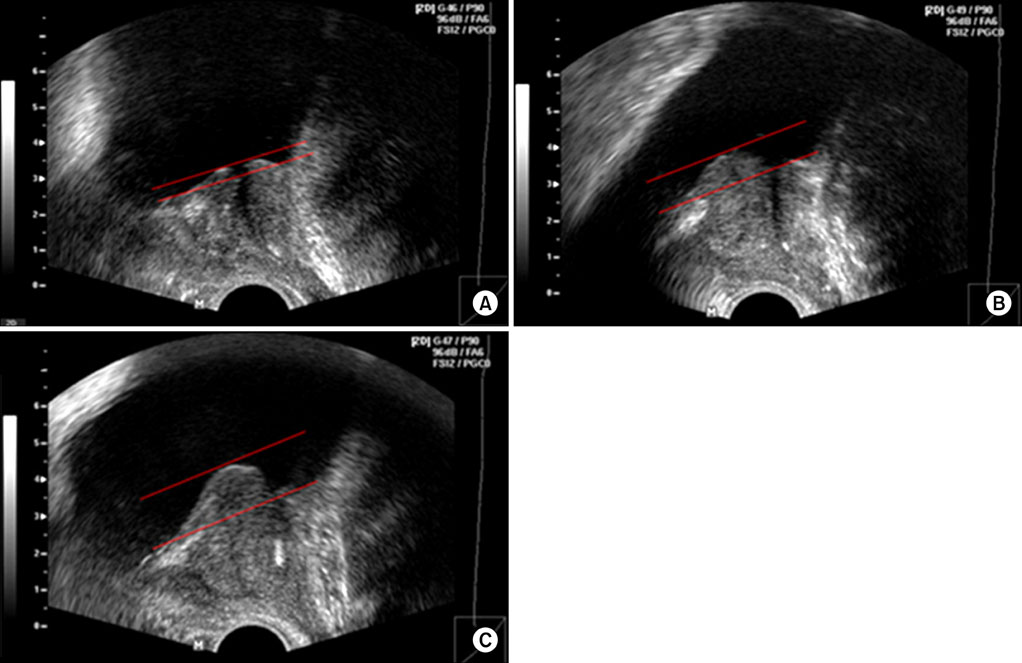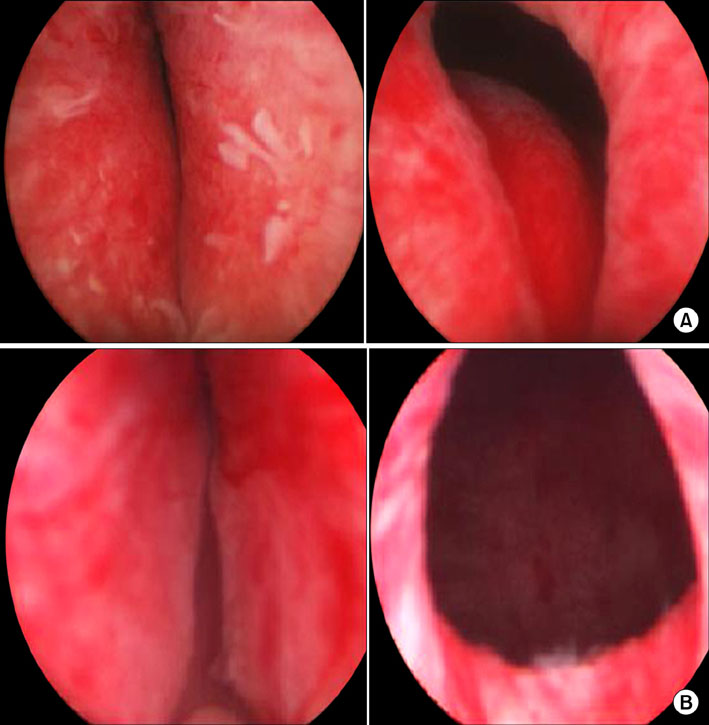Korean J Urol.
2010 Oct;51(10):694-699.
Clinical and Urodynamic Significance of Morphological Differences in Intravesical Prostatic Protrusion
- Affiliations
-
- 1Department of Urology, Eulji Hospital, Eulji University School of Medicine, Seoul, Korea. ytk5202@eulji.ac.kr
Abstract
- PURPOSE
The objectives of this study were to evaluate whether morphologic differences correlated with urodynamic and clinical characteristics in patients with benign prostatic hyperplasia (BPH) with intravesical prostatic protrusion (IPP) of trilobar or bilobar adenoma.
MATERIALS AND METHODS
Between January 2008 and June 2009, 72 male patients who had undergone transurethral resection (TUR) owing to BPH with IPP were included in this study. They underwent preoperative urodynamic studies, the International Prostate Symptom Score (IPSS)/quality of life (QoL), maximal flow rate (Qmax), post-voiding residual urine volume (PVR), transrectal ultrasonography (TRUS), and serum prostate-specific antigen (PSA) measurement. The patients were classified into 2 groups (the trilobar and bilobar adenoma groups) on the basis of video findings during the TUR operation.
RESULTS
The trilobar and bilobar adenoma groups consisted of 37 patients and 35 patients, respectively. The Mean+/-SD IPP, prostate volume (PV), and transition zone volume of the trilobar and bilobar adenoma groups were 11.8+/-5.2 mm and 9.0+/-3.8 mm (p=0.014), 81.1+/-25.8 g and 59.3+/-22.5 g (p<0.001), and 49.6+/-20.6 g and 34.8+/-19.4 g (p=0.003), respectively. The Mean+/-SD PSA, bladder contractility index (BCI), and bladder outlet obstruction index (BOOI) were 4.6+/-2.5 ng/ml and 3.5+/-1.7 ng/ml (p=0.042), 119.8+/-33.4 and 87.7+/-24.4 (p<0.001), and 62.6+/-29.5 and 44.6+/-20.4 (p=0.005), respectively. There were no significant differences in IPSS/QoL, Qmax, PVR, acute urinary retention, or detrusor overactivity in the 2 groups.
CONCLUSIONS
IPP has two morphologic types of trilobar or bilobar enlargement. The PV, BOOI, and BCI were significantly smaller in the bilobar adenoma group than in the trilobar adenoma group.
Keyword
MeSH Terms
Figure
Reference
-
1. Lim KB, Ho H, Foo KT, Wong MY, Fook-Chong S. Comparison of intravesical prostatic protrusion, prostate volume and serum prostatic-specific antigen in the evaluation of bladder outlet obstruction. Int J Urol. 2006. 13:1509–1513.2. Chung HY, Han DS, Jang YS, Song KH. The influences of bladder outlet obstruction on improvement of storage symptoms in patients who underwent transurethral resection of prostate. Korean J Urol. 2008. 49:912–916.3. Abrams P. Bladder outlet obstruction index, bladder contractility index and bladder voiding efficiency: three simple indices to define bladder voiding function. BJU Int. 1999. 84:14–15.4. Jung YS, Hwang TK, Kim JC. The outcome and satisfaction of patients with lower urinary tract symptoms/benign prostatic hyperplasia following transurethral resection of the prostate according to urodynamic obstruction and the bladder function. Korean J Urol. 2007. 48:965–970.5. Chia SJ, Heng CT, Chan SP, Foo KT. Correlation of intravesical prostatic protrusion with bladder outlet obstruction. BJU Int. 2003. 91:371–374.6. Doo CK, Uh HS. Anatomic configuration of prostate obtained by noninvasive ultrasonography can predict clinical voiding parameters for determining BOO in men with LUTS. Urology. 2009. 73:232–236.7. Mariappan P, Brown DJ, McNeill AS. Intravesical prostatic protrusion is better than prostate volume in predicting the outcome of trial without catheter in white men presenting with acute urinary retention: a prospective clinical study. J Urol. 2007. 178:573–577.8. Rosier PF, de Wildt MJ, Wijkstra H, Debruyne FF, de la Rosette JJ. Clinical diagnosis of bladder outlet obstruction in patients with benign prostatic enlargement and lower urinary tract symptoms: development and urodynamic validation of a clinical prostate score for the objective diagnosis of bladder outlet obstruction. J Urol. 1996. 155:1649–1654.9. el Din KE, Kiemeney LA, de Wildt MJ, Rosier PF, Debruyne FM, de la Rosette JJ. The correlation between bladder outlet obstruction and lower urinary tract symptoms as measured by the international prostate symptom score. J Urol. 1996. 156:1020–1025.10. Nose H, Foo KT, Lim KB, Yokoyama T, Ozawa H, Kumon H. Accuracy of two noninvasive methods of diagnosing bladder outlet obstruction using ultrasonography: intravesical prostatic protrusion and velocity-flow video urodynamics. Urology. 2005. 65:493–497.11. Kuo HC. Clinical prostate score for diagnosis of bladder outlet obstruction by prostate measurements and uroflowmetry. Urology. 1999. 54:90–96.12. Keqin Z, Zhishun X, Jing Z, Haixin W, Dongqing Z, Benkang S. Clinical significance of intravesical prostatic protrusion in patients with benign prostatic enlargement. Urology. 2007. 70:1096–1099.13. Tan YH, Foo KT. Intravesical prostatic protrusion predicts the outcome of a trial without catheter following acute urine retention. J Urol. 2003. 170:2339–2341.14. Chancellor MB, Rivas DA, Keeley FX, Lotfi MA, Gomella LG. Similarity of the American Urological Association Symptom Index among men with benign prostate hyperplasia (BPH), urethral obstruction not due to BPH and detrusor hyperreflexia without outlet obstruction. Br J Urol. 1994. 74:200–203.
- Full Text Links
- Actions
-
Cited
- CITED
-
- Close
- Share
- Similar articles
-
- Corrigendum: Acknowledgments. Effect of Photoselective Vaporization Prostatectomy on Lower Urinary Tract Symptoms in Benign Prostatic Hyperplasia With or Without Intravesical Prostatic Protrusion
- The Usefulness of Intravesical Prostatic Protrusion and Bladder Wall Thickness Measurement Using Transabdominal Ultrasound in Patients with Benign Prostatic Hyperplasia
- The role of prostatic urethral angle and intravesical prostatic protrusion on surgical capsule calculi formation in the prostate: A retrospective study
- Defining the Degree of Intravesical Prostatic Protrusion in Association With Bladder Outlet Obstruction
- The Clinical Implication of Intravesical Prostatic Protrusion to Lower Urinary Tract Symptoms in Patients of Prostatic Volume 30~50gm




